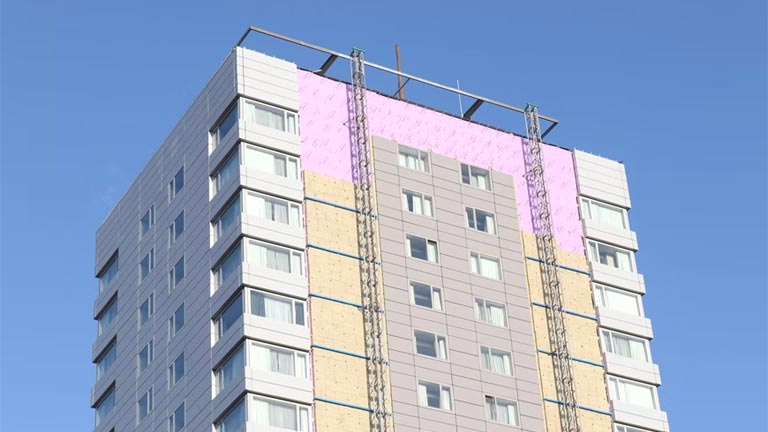Architecture, which in many ways is simply an applied form of art, is something that is constantly evolving. Every few decades, new architectural movements emerge, challenging our old ways of thinking and replacing them with something new.
While modernism helped many cities develop and use their space more efficiently, many architectural critics felt it was “soulless” and lacked artistic character. The post-modernism architectural movement emerged in the 1960s, largely in response to the exhausted designs of the past.
Post-modernism is a comprehensive art and architectural movement with many defining features. While there is an incredibly wide range of buildings that can be classified as post-modern, there are still quite a few recognizable themes. In this article, we will discuss eight of the defining features of postmodern architecture.
1. Asymmetrical Shapes
 As building styles and technologies changed, designing asymmetrical buildings became much more feasible. Many post-modern buildings have no clear form, such as the Walt Disney Concert Hall featured below. Curved steel and overlapping floors are common.
As building styles and technologies changed, designing asymmetrical buildings became much more feasible. Many post-modern buildings have no clear form, such as the Walt Disney Concert Hall featured below. Curved steel and overlapping floors are common.
2. Ample Use of Glass
 Over time, building with glass has become much more feasible. Glass helps increase the amount of natural light in a building, which is something that many mid-century brutalist structures are lacking. The Crystal Cathedral, also located in California, presents one of the most interesting uses of glass to-date.
Over time, building with glass has become much more feasible. Glass helps increase the amount of natural light in a building, which is something that many mid-century brutalist structures are lacking. The Crystal Cathedral, also located in California, presents one of the most interesting uses of glass to-date.
3. Complex Details
 While modern architecture often uses raw, geometric, and easy to replicate forms, postmodern architecture often relies on using much more complex details. Many buildings have a form that is almost impossible to describe in a single word, such as the buildings found in central Zaandam. While these buildings rely on old Dutch styles and materials, they present them in an entirely new and different way.
While modern architecture often uses raw, geometric, and easy to replicate forms, postmodern architecture often relies on using much more complex details. Many buildings have a form that is almost impossible to describe in a single word, such as the buildings found in central Zaandam. While these buildings rely on old Dutch styles and materials, they present them in an entirely new and different way.
4. Fragmentation
 Fragmentation is a term used to describe buildings that are constructed with multiple different components. In postmodern architecture, these buildings will often be connected in complex ways, such as bridges, tunnels, or even outdoor walkways. The Denver public library is a perfect example of a building that deliberately uses fragmentation in order to make a statement.
Fragmentation is a term used to describe buildings that are constructed with multiple different components. In postmodern architecture, these buildings will often be connected in complex ways, such as bridges, tunnels, or even outdoor walkways. The Denver public library is a perfect example of a building that deliberately uses fragmentation in order to make a statement.
5. Contradiction
 Juxtaposition has always played an important role in architecture theory. However, its importance has notably increased over the past few years. Juxtaposing buildings and features with entirely different forms—such as the old and new additions to the Louvre – helps create a very interesting aesthetic. The contradiction is especially popular in cities with highly preserved historic districts.
Juxtaposition has always played an important role in architecture theory. However, its importance has notably increased over the past few years. Juxtaposing buildings and features with entirely different forms—such as the old and new additions to the Louvre – helps create a very interesting aesthetic. The contradiction is especially popular in cities with highly preserved historic districts.
6. Curves
 Postmodernism is largely characterized by the rejection of traditional forms and structures. Unsurprisingly, this new attitude has inspired many architects to replace traditional straight lines with curves. While using more curves may occasionally decrease the functionality of a building, it establishes a fresh aesthetic that many architects prefer. Stockholm’s “Turning Torso” is an excellent example of curved design.
Postmodernism is largely characterized by the rejection of traditional forms and structures. Unsurprisingly, this new attitude has inspired many architects to replace traditional straight lines with curves. While using more curves may occasionally decrease the functionality of a building, it establishes a fresh aesthetic that many architects prefer. Stockholm’s “Turning Torso” is an excellent example of curved design.
7. Color
 One of the common complaints about modern buildings was that these buildings were often bland and entirely void of color. In response, many new buildings use color schemes that are bright and attract attention. The Cambridge Judge Business School has a “playful” interior that utterly rejects older color schemes.
One of the common complaints about modern buildings was that these buildings were often bland and entirely void of color. In response, many new buildings use color schemes that are bright and attract attention. The Cambridge Judge Business School has a “playful” interior that utterly rejects older color schemes.
8. Environmentally Conscious
While Frank Lloyd Wright helped promote the blending of buildings and natures, it was not until later that architects began to really think about the impact their buildings have on the environment. The increased use of plants, the decreased use of carbon, and other environmentally friendly design features have all become quite popular. Milan’s Vertical Forest is a building ahead of its time.
Around the middle of the 20th Century, modernism was recognized as a dominant form of both residential and commercial architecture. While difficult to define, modernism was largely characterized by symmetry, functionality, and an ongoing emphasis on building volume.
Conclusion – Post-Modern Architecture
While postmodern architecture overlaps with other movements (such as modernism and neo-futurism), it has still left a very distinctive mark on the world. Each of the details mentioned in this article is often found in postmodern structures. They have changed the way we think about design and, consequently, they’ve changed the way we think about our world.




